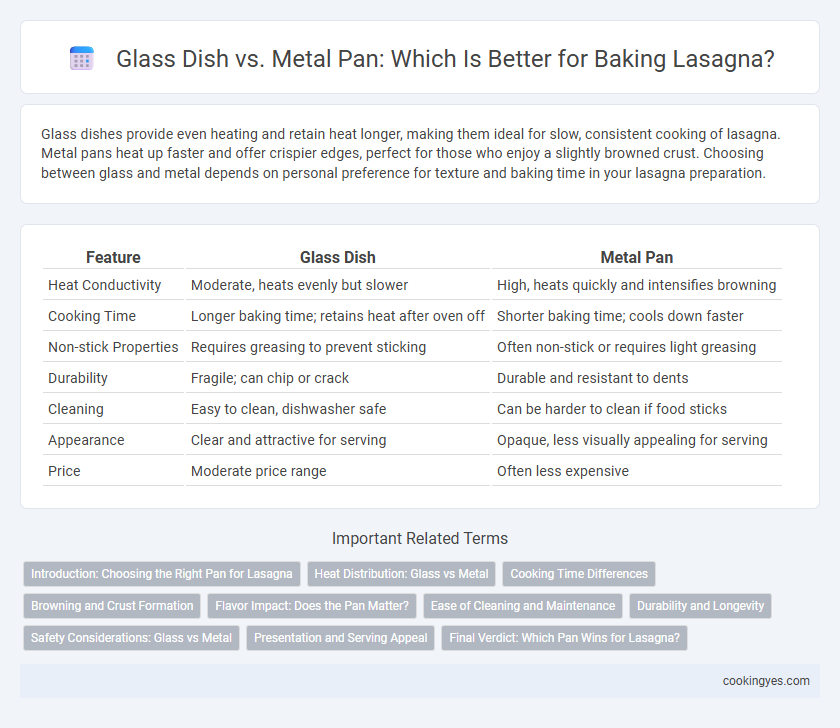Glass dishes provide even heating and retain heat longer, making them ideal for slow, consistent cooking of lasagna. Metal pans heat up faster and offer crispier edges, perfect for those who enjoy a slightly browned crust. Choosing between glass and metal depends on personal preference for texture and baking time in your lasagna preparation.
Table of Comparison
| Feature | Glass Dish | Metal Pan |
|---|---|---|
| Heat Conductivity | Moderate, heats evenly but slower | High, heats quickly and intensifies browning |
| Cooking Time | Longer baking time; retains heat after oven off | Shorter baking time; cools down faster |
| Non-stick Properties | Requires greasing to prevent sticking | Often non-stick or requires light greasing |
| Durability | Fragile; can chip or crack | Durable and resistant to dents |
| Cleaning | Easy to clean, dishwasher safe | Can be harder to clean if food sticks |
| Appearance | Clear and attractive for serving | Opaque, less visually appealing for serving |
| Price | Moderate price range | Often less expensive |
Introduction: Choosing the Right Pan for Lasagna
Glass dishes provide even heat distribution and retain warmth longer, ideal for slow, consistent baking of lasagna. Metal pans heat up quickly and promote crispy edges, perfect for those who prefer a slightly browned top layer. Selecting the right pan depends on desired texture and heat conduction preferences, impacting the final lasagna quality.
Heat Distribution: Glass vs Metal
Glass dishes distribute heat more evenly but retain heat longer, resulting in slower cooking and a browned, crispy crust ideal for lasagna. Metal pans, especially aluminum, heat rapidly and provide intense, direct heat, promoting quicker cooking and sharper browning. Choosing between glass and metal impacts the texture and doneness of lasagna layers due to their distinct thermal conductivity and heat retention properties.
Cooking Time Differences
Glass dishes typically require longer cooking times for lasagna because they heat more slowly and retain heat evenly, ensuring thorough cooking. Metal pans conduct heat faster and can reduce baking time by 5 to 10 minutes, resulting in a crisper crust. Choosing between glass and metal impacts both the texture and overall cooking duration of lasagna.
Browning and Crust Formation
Glass dishes provide even heat distribution, resulting in consistent browning and a tender crust on lasagna, while metal pans heat up faster and produce a crispier, more pronounced crust due to higher direct heat conduction. The slower heat transfer of glass allows for thorough cooking without burning, preserving moisture in the layers. Metal pans are preferred for those seeking a well-defined, golden-brown edge and firmer crust texture.
Flavor Impact: Does the Pan Matter?
Glass dishes provide even heat distribution, which ensures the lasagna cooks uniformly and preserves moisture, enhancing the rich, layered flavors. Metal pans, especially aluminum, heat up faster and produce a crispier, caramelized edge that intensifies the taste profile through Maillard reactions. Choosing between glass and metal pans ultimately influences the texture and flavor depth of baked lasagna, with glass promoting tenderness and metal contributing a savory crust.
Ease of Cleaning and Maintenance
Glass dishes for lasagna baking offer non-porous surfaces that resist staining and make it easier to remove baked-on cheese and sauce, simplifying cleaning and maintenance. Metal pans, especially those with non-stick coatings, provide quick food release but may require more careful hand washing to avoid scratching and preserve the coating. Over time, glass maintains its clarity and durability without warping, while metal pans can warp or discolor, impacting their long-term ease of cleaning and upkeep.
Durability and Longevity
Glass dishes offer excellent heat retention and even baking but are more prone to cracking or shattering over time, especially under sudden temperature changes. Metal pans, typically made from aluminum or stainless steel, provide superior durability and resistance to warping, ensuring longer lifespan with consistent use. For frequent lasagna bakers seeking long-term reliability, metal pans are generally the preferred choice due to their robustness and ability to withstand high oven temperatures without damage.
Safety Considerations: Glass vs Metal
Glass dishes offer even heat distribution and allow you to monitor lasagna browning, but they are more prone to shattering under rapid temperature changes compared to metal pans. Metal pans, typically made from aluminum or stainless steel, provide faster heating and crispy edges but may cause uneven cooking if heat distribution is poor. When prioritizing safety, avoid sudden temperature shifts in glass bakeware and ensure metal pans are free from sharp edges or rust to prevent injury and food contamination.
Presentation and Serving Appeal
Glass dishes offer a clear view of lasagna's layers, enhancing presentation by showcasing the dish's vibrant colors and textures, making it visually appealing for serving. Metal pans heat evenly, producing a crispier, golden-brown crust that adds an appealing texture contrast and enhances the dish's overall serving appeal. Both options elevate lasagna presentation, with glass emphasizing visual layers and metal enhancing crust and texture, catering to different serving preferences.
Final Verdict: Which Pan Wins for Lasagna?
Glass dishes retain heat evenly, ensuring consistent cooking and a nicely browned crust on lasagna, while metal pans heat faster and provide crispier edges due to better thermal conductivity. Home cooks seeking a golden, crunchy finish may prefer metal pans, but those prioritizing even cooking and easy monitoring through transparency often choose glass dishes. Overall, metal pans win for achieving traditional lasagna textures, but glass offers reliable, uniform baking results.
Glass dish vs Metal pan for lasagna baking Infographic

 cookingyes.com
cookingyes.com